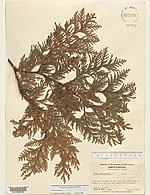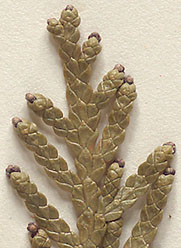
(Thuja occidentalis)
 |
||
| Northern white-cedar (Thuja occidentalis) |
||
Scope: The Key to the Gymnosperms of the Southeastern U.S. includes all gymnosperm species that are native to the southeastern states, along with nonnatives that are naturalized or are commonly planted throughout the region. (The southeastern U.S. is treated here as including Arkansas, Louisiana, and east Texas, along with states east of the Mississippi River, and south of a line defined by the northern borders of Kentucky, West Virginia, Maryland and Delaware.) Many of the less common nonnative species that are cultivated in the region are not included here. In addition, some ornamental varieties of gymnosperms cannot be properly identified using the key.
Using the Key: On each page of the key you are asked to consider two or three botanical descriptions and compare them to characteristics of the particular gymnosperm tree or shrub you wish to identify. Choose the description that best fits your plant for each of the features described. To do this it's helpful to have a clipping with several leaves from your plant on hand. (Because leaf form can vary from one part of a plant to another, try to make sure that the branchlet you choose has leaves that seem typical of those on the plant overall.) With evergreen plants look for needles or scales that are at least a year old, i.e. not the most recent growth at the end of the branch. Unless otherwise indicated, measurements for evergreen foliage are for leaves that are a year or more old. The key relies primarily on leaf characteristics, but in some cases requires that you have access to cones or other features in order to make a correct identification.
As you progress though the key a summary of all the choices you've made to that point is displayed in the lower left portion of each page. Clicking on a previous choice will return you to the page where that choice was made. (Clicking on the topmost choice always returns you to the start of the key.) Links to definitions of botanical terms are given in the lower right portion of each page on which they occur.
In order to clearly see certain characteristics described
in the key it's sometimes necessary to look at parts of your specimen using
a hand lens or other form of magnification. This is indicated throughout the
key by the presence of the magnifying glass icon. ![]()
 |
||
| Northern white-cedar (large scale detail image) |
||
The images that illustrate the key provide examples of the distinguishing features of the plants. When viewing the images, try to observe how each one illustrates the specific characteristics being described in order to avoid being confused by other aspects of the photographed plant's appearance. These other aspects may differ significantly from those of the plant you are trying to identify. Placing the mouse pointer on an image will popup text indicating what characteristic(s) the image is intended to portray. Please note that most of the images in the key were taken of dried herbarium specimens, and often differ in color from those of live plants.
The key is best viewed on a display set to a resolution of 1024 x 768 pixels, or higher. Whenever possible, set the color on your computer's display to True Color (IBM-compatible) or Millions of Colors (Apple).
Scale of Images: The relative size of images varies throughout the key depending on the characteristics being illustrated. The largest scale images will appear several times larger than life size. In order to make comparisons easier all images on a given page are shown at the same scale, except where additional close-up images are included. Scale bars are displayed below each image, or group of images, of the same scale.
Development: The key was developed by compiling data from botanical descriptions contained in published sources and by examining herbarium specimens in the University of North Carolina Herbarium (NCU). Several published keys were also consulted. Click the following for a list of all published sources used in preparing the key. The key was created by Stephen M. Seiberling based on an original version by Brenda L. Wichmann.